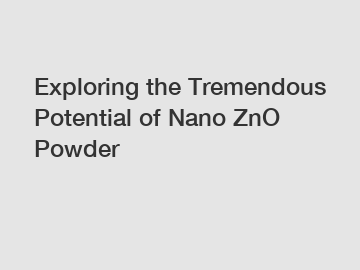Exploring the Tremendous Potential of Nano ZnO Powder.
Nano ZnO powder, also known as zinc oxide nanoparticle, has gained considerable attention in recent years due to its remarkable properties and versatile applications. In this article, we will dive into the tremendous potential of nano ZnO powder, discussing its origin, the evidence supporting its capabilities, and the implications of its usage.
The tremendous potential of nano ZnO powder stems from its unique properties at the nanoscale. As an inorganic semiconductor material, it exhibits excellent electrical, optical, and catalytic properties. At the nanoscale, ZnO particles possess a large surface area to volume ratio, leading to enhanced reactivity and surface energy. This, in turn, enables a wide range of applications in various fields.

One significant application of nano ZnO powder lies in the field of photocatalysis. The large surface area of nanoscale ZnO particles provides ample active sites, allowing for effective interaction with photons. When exposed to ultraviolet light, ZnO nanoparticles can generate electron-hole pairs, initiating various photochemical reactions. This photocatalytic process has been extensively explored for environmental purification, such as air and water treatment, effectively decomposing pollutants into harmless substances.
Furthermore, nano ZnO powder showcases impressive antibacterial properties, making it an ideal candidate for medical applications. Numerous studies have demonstrated its capability to inhibit the growth of various bacteria, including multidrug-resistant strains. The unique mechanism behind this antibacterial activity lies in the release of zinc ions from the nanoparticles, which disrupts the bacterial membrane and impairs essential cellular processes. Harnessing this property, nano ZnO powder can be utilized in wound dressings, medical implants, and sanitizing coatings to combat infections and promote healing.
In addition to its photocatalytic and antibacterial properties, nano ZnO powder has also shown promise in the field of electronics. Its exceptional electrical properties, such as high electron mobility and excellent thermal stability, make it a potential candidate for electronic devices. Researchers have successfully integrated ZnO nanoparticles into transistors, diodes, and sensors, paving the way for more efficient and miniaturized electronic components.
The exploration of the tremendous potential of nano ZnO powder holds significant implications and impacts various industries. With the increasing global concern about environmental pollution, the photocatalytic application of nano ZnO powder offers a sustainable and effective solution for purification processes. Its antibacterial properties provide a viable option for combating the rise of antibiotic resistance and preventing nosocomial infections in healthcare settings. Furthermore, its potential utilization in electronic devices opens up possibilities for advancing technology and enhancing device performance.
In conclusion, nano ZnO powder offers immense potential across different fields due to its unique properties at the nanoscale. The evidence supporting its capabilities in photocatalysis, antibacterial activity, and electronics is well-documented. Exploring and harnessing these properties can revolutionize various industries, positively impacting our environment, healthcare, and technological advancements.
If you want to learn more, please visit our website Textile-grade Silver Antibacterial Powder, Textile-grade Silver Antibacterial Powder, nanosilver antibacterial powder.



Comments
Please Join Us to post.
0